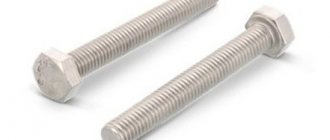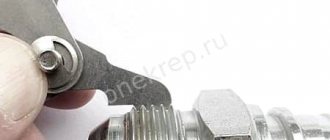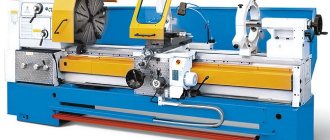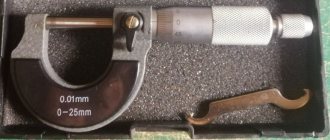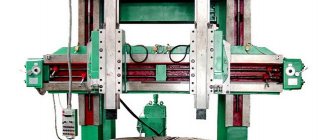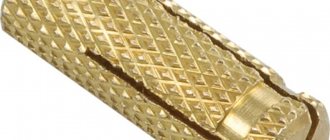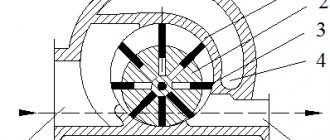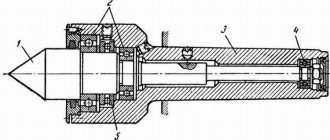Main types of bolts
In accordance with GOST 27017-86 “Fastening products. Terms and definitions "bolt" is a fastener in the form of a rod with an external thread at one end, with a head at the other, forming a connection using a nut or threaded hole in one of the connected products. Note that a screw receives a similar definition in the standard: a fastener for forming a connection or fixation, made in the form of a rod with an external thread at one end and a structural element for transmitting torque at the other.
There is still no complete clarity on the question of how a bolt differs from a screw. For example, a bolt is sometimes considered to have an incomplete thread, although there are bolts with full threads. If the thread is not made along the entire length of the bolt, then the diameter of the smooth part of the rod is approximately the same as the diameter of the thread measured at the tops of its turns. But there are also exceptions.
Sometimes they say that a bolt must have a hex head. But, at the same time, bolts are products with a semicircular and countersunk head. Let's look at the most popular bolt options available in the TsKI assortment.
The hex head is produced in several modifications: basic, with a support ledge, with a collar, with a flange.
Bolts with hexagonal head and main thread are divided into bolts with full (DIN 933) and partial thread (DIN 931) and fine and ultra-fine thread pitch (DIN 960 and DIN 961).
Separately, hex head bolts with an increased spanner size are available for highly loaded prestressed threaded connections in steel structures DIN 6914.
Bolts with a reduced wrench size are available in a variety of designs.
Along with hex heads, bolts can have a semicircular head:
low with square head (DIN 603) with mustache (DIN 607)
And the secret head:
with mustache (DIN 604) with high and low square head (DIN 608)
The definition of “furniture” is consistently applied to such bolts. This is partly due to the fact that some of them are widely used in furniture production. At the same time, the mustache and headrests prevent the product from turning during assembly.
Examples of bolts called by purpose are “hinged” and “welded”.
Instead of the usual head, the DIN 444 hinged bolt has a bushing with a through hole - it is also called a ring. Typically, the bushing sits on an axle and the bolt rotates around it. The thickness of the ring and the length of the thread in the design may vary.
A welded bolt looks little like a bolt at all. In place of his head there is a small cylindrical protrusion. Often this product is also called a welded pin.
It is he who ensures butt welding of the bolt and the base. Instead of a threaded cylinder, other external elements can be welded.
The formal name “bolt” also includes anchor and fitting bolts.
Anchor bolts are designed to be embedded in concrete. Their rod has a thread at one end - the one that goes out. The shape of the other end may vary.
Its task is to provide maximum resistance to the anchor being pulled out from the base. Therefore, the second end is given an expanding shape. When installing the bolt, this part is lowered into the hole and filled with concrete.
A fit bolt is a bolt whose diameter of the smooth part of the rod allows it to be installed without a gap in a precisely machined hole. For this purpose, the threaded part is made of a deliberately smaller diameter.
A “fit” bolt DIN 609 is a distortion of “precision”, that is, high accuracy. Also used as fitting bolts are “Bolts with a hexagonal reduced head of accuracy class A for holes from under the reamer. GOST 7817-80".
Materials
Bolts and bolt sets are manufactured from carbon structural alloy steel. To increase strength and improve performance characteristics, the following coating is applied:
- zinc;
- chrome;
- titanium;
- multilayer.
They also produce hardware from alloys: brass, copper, aluminum. Some special bolts or bolt elements are made from engineering plastics or composite materials.
High-strength bolts, as well as the nuts and washers used with them, are hot-dipped galvanized for added strength and corrosion protection. In addition, lamella or thermal diffusion coatings can be used. It is also possible to apply other protective compounds to order, taking into account the specific use of hardware.
Screw classification
Let us now consider the screws available in the TsKI assortment. The largest group of them are general purpose screws. We meet them every day in everyday life and at work. They all have a fully threaded shaft (although there are exceptions) and different shaped heads. The heads have slots or recesses for different types of keys.
- Screw with a cylindrical head (actually slightly beveled to a cone) and a straight slot DIN 84.
- Pan head screw with straight slot DIN 85.
- ISO 7380 Pan Head Hex Socket Screw.
- Round head screw with shoulder and hexagonal socket ISO7380 version. 2.
- Socket head screw with sphere and Phillips recess Pz, Ph DIN 7985.
- Pan head screw with sphere, radial holes and straight slot. Sealing, DIN 404.
- Countersunk head screw with straight slot DIN 963.
- Countersunk Phillips head screw DIN 965.
- Countersunk hex socket head screw DIN 7991.
- Slotted head screw DIN 964.
- Semi-countersunk Phillips head screw DIN 966.
- Oversized flat head screw with straight slot DIN 921.
- Screw with a semicircular low head, with a collar and a cross-shaped combination slot.
- Hex socket head screw DIN 912.
- Low socket head screw with hexagon socket DIN 7984.
- Low socket head screw with hex socket and key guide DIN 6912.
Another large group of screws are set screws. The name comes from their purpose. For the most part, they are designed for precise installation and fixation of parts in mechanisms. To do this, they have various protrusions or recesses at their ends.
According to GOST 12414-94 (ISO 4753:1999): “Ends of bolts, screws and studs. Dimensions" the following setscrew ends are provided:
The torque is driven by the following elements:
The summary table shows the actual, most common combinations of setscrew heads and ends, indicating the DIN standard.
| Conical | Flat | Cylindrical | Drilled | |
| Straight spline | DIN 553 | DIN 551 | DIN 417 | DIN 438 |
| Hexagonal with key socket | DIN 914 | DIN 913 | DIN 915 | DIN 916 |
Furniture screws are presented in two products:
- a screw for furniture handles with a semicircular head, a shoulder and a combined slot;
- furniture screw with a flat head and a hexagonal socket:
A group of screws has different types of hook and loop heads:
- hook screw
- loop screw
- L-hook screw
- spiral hook screw (twisted)
The wing screw DIN 316 is available in two modifications, differing in the shape of the wings. The more pointed ones belong to the so-called. "American" form.
Classic thumbscrew “American” form of thumbscrew
The DIN 7516 thread cutting screw has a tap-like end with which it cuts metric threads in a pre-drilled hole.
As for the heads, there are quite a lot of them used:
- AE – cylindrical head with a sphere and a cross-shaped slot;
- DE – countersunk head with a cross-shaped slot;
- EE – semi-countersunk head with a cross-shaped slot;
- A – hexagonal head;
- BE – cylindrical head with straight slot;
- FE – countersunk head with straight slot;
- GE – semi-countersunk head with a straight slot.
Another screw that independently forms a thread - DIN 7500 extrudes it in the initially applied smooth hole. This is convenient when installing products with one-way access and significantly increases the connection density, especially with a metal sheet. Its end has the shape of a triangular rod with a leading part and a smooth thread run-out.
Innovations to improve the reliability of bolted connections
The proposed solutions for adjusting the force with which the bolt is tightened are not always convenient. Such solutions include the angle of rotation of the nut, the amount of torque, lengthening the bolt, as well as turning the complete washer together with the signal washer and other methods. They are inconvenient because you need to use locknuts, spring nuts and other devices. When using them, the exact tightening force is unknown. To determine it, you need a calibrated torque wrench, and the master does not always have such a tool.
To solve this problem, a method for visualizing the tightening force of bolts was developed: a special indicator is integrated into the hardware, which changes color in accordance with the force applied to tighten it. Such bolts with visual indication are used for high-precision connections. For normal operation of typical objects they are excessive.
Execution option
One of the main design features can be called a design option, which depends on the standard to which the hardware is manufactured. The generally accepted standards are GOST and DIN.
For example, in hex bolts, a distinctive feature may be the locking of the threaded connection. It is achieved through a hole through which a cotter pin or wire is threaded. If it is necessary to reduce the weight of the fastener without losing the strength of the connection, then a recess can be made in the head of the bolt.
What is the difference between a nut and a washer: comparison, photo
The nut is also significantly different from the washer. The fact is that the nut has a thread inside. A washer is a component that is typically used to seal the joint between a bolt and a nut. That is, it is inserted immediately before screwing on the nut. This helps improve the connection. This minimizes the possibility of unscrewing, unscrewing the nut and removing it from the surface of the bolt. There are different types of washers, both flat and shaped. They are also called growers. Additional pressure improves the adhesion of the bolt and nut and makes the connection of the parts more reliable.
screw
Washer
As you can see, there are many fasteners and parts that are used to connect components, mechanisms and structures. They have a large number of differences and are used in each specific case.
What is the difference between a screw and a self-tapping screw: comparison, photo
The self-tapping screw itself is a type of screw, but differs in some ways. The fact is that the technology for making self-tapping screws is somewhat more complicated. Since harder, more durable materials are used for manufacturing, which can destroy the surface with a certain force. For example, a self-tapping screw can be screwed in without making a separate hole, just apply some effort. Screwed in from a certain force. This way the screw will fit tightly into the surface of the wood or other material. In order to insert a screw, you must first make a hole on the surface.
Screw
That is, the screw itself cannot be screwed in without making an additional hole. Since the material is quite fragile and the edge is not so strong. They are not so sharp, so screwing without an additional hole is quite difficult. In addition, the screw is not as tall and has a smaller thread pitch. In this case, the tip of the self-tapping screw is sharper than that of a screw.
Self-tapping screws
